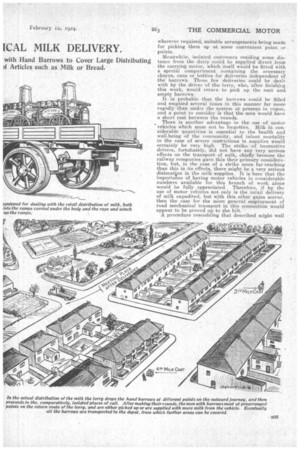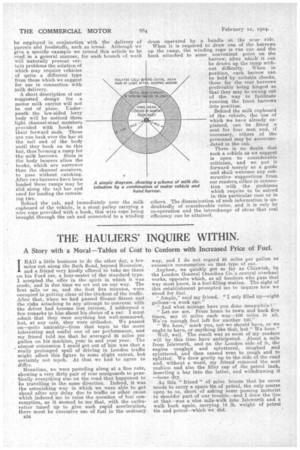A SCHEME FOR ECOls ICAL MILK DELIVERY.
Page 16

Page 17

Page 18

If you've noticed an error in this article please click here to report it so we can fix it.
NTO ONE reviewing the extraordinary rapidity with which the motor vehicle has ousted other methods of transport in connection with the collection and delivery of goods can believe that we have yet reached finatity in this respect. It appears to us that there are still many spheres of activity where the motor vehicle might prove a factor of the utmost importance in expediting the handling of goods and foodstuffs and, at the same time, greatly promoting the all-round efficiency of transport systems and reducing labour and other costs.
Take, for instance, the house-to-house delivery of milk. Performed in the usual way, it is not only a laborious undertaking, but the area which can be covered by men wheeling the ordinary typ6 of hand milk barrow, is extremely limited and, consequently, the scope for the enlargement of any particular dairy is curtailed by this delivery factor. In large towns and cities the trouble has, to a. certain extent, been overcome by the inauguration of a large number of milk depots, but this may not always prove a paying proposition in smaller Communities.
We suggest as a feasible plan that a special motor vehicle shouldbe designed, resembling that which we illustrate, and one or more of these should be used in connection with each dairy wishing to extend its radius of delivery. Although, for clearness' sake, only two milk barrows are shown in our drawing, a vehicle of this, type could easily be constructed to convey four, or even more, at a time, together with their complement of men.
By this means a well-devised system for expediting deliveries could easily be worked out. For instance, those streets within half a mile or so of the dairy could be worked in the ordinary way by hand barrows • beyond this distance, extra barrows could be carried on • the motor vehicle and off-loaded wherever required, suitable arrangements being made for picking them up at some convenient 'point or points.
Meanwhile, isolated customers residing some distance from the dairy could be supplied direct from the carrying motor, which itself, would be fitted with a special compartment containing the necessary churns, cans or bottles for deliveries independent of the' barrows. These few deliveries could be dealt with by the driver of the lorry, who, after finishing this work, would return to pick up the men and. empty barrows.
It is probable that the barrows could be filled and emptied several times in this manner far more rapidly than under the system at present in vogue, and a point to consider is that the inen Would have a short rest between the rounds.
There is another advantage in the use of motor 'vehicles which must not be forgotten. Milk in considerable quantitiesis essential to the health and well-being of the community, and infant mortality in the case of severe restrictions in supplies would certainly be very high. The strike of locomotive drivers,. fortunately, "did not have any very serious effects on the transport ci milk, chiefly because the railway companies gave this their .primary consideration, but, in the case of a strike more far-reaching than this in its effects, there might be a very serious dislocation in the milk supplies. It is here that the importance of having motor, vehicles in considerable numbers available for this branch of work alone would 'be fully appreciated. Therefore, if by the use of motor vehicles not only is the retail delivery of milk expedited, but with this other gains accrue, then the case for the more general employment of road mechanical transport in this connection would appear to be proved up to the hilt.
A procedure resembling that described might well be employed in conjunction with the delivery of parcels ahd foodstuffs, such as bread. Although we
give a specific example we intend this article to be read in a general nianner, for each branch of work will naturally present certain problems the solution of which may require vehicles of quite a different type from those which we suggest for use in connection with 1-nilk delivery.
A short description of our suggested design for a motor milk carrier will not be out of place. Underneath the low-sided lorry body will be noticed three light channel-steel members provided with hooks at their forward ends. These are tun back over the bar at the tail end, of the body until they hook on to this bar, thus forming a ramp for the milk barrows. Slots in the body bearers allow the hooks, which are narrower than the channel members, to pass without catching. After two barrows have been loaded these ramps may be slid along the tail bar and used for loading the remaining two.
Behind the cab, and immediately over themilk cupboard of the vehicle, is a stout pulley carrying a wire rope provided with a hook, thiS wire rope being brought through the cab and connected to a winding
ISOLATED CALLS REMADE BY LORRY AFT
drum operated by a handle at the near side. When it is required to draw one of the barrows up the• ramp, the winding rope is run out and the hook attached to some convenient point on the barrow, after which it can be drawn up the ramp without difficulty. When in position, each barrow can
ND OLITM. ARE-4 be held by suitable chocks, 5. DROPPING BARROW] those for the rear barrows
preferably being hinged so that they may be swung out of the way to facilitate running the front barrows into position.
Behind the milk cupboard of the vehicle, the use of which we have already explained, can be fitted a seat for four men and, if
necessary, others of the personnel may be accommo_ dated in the cab.
There is no doubt that such a vehicle as we suggest is open to considerable criticism, and we put it forward merely as a guide and shall welcome any constructive suggestions from our readers, either in connection with the problems which require to be solved in this particular case or in others. The dissemination of such information is undoubtedly of considerable value, and it is only by co-operation and the interchange of ideas that real efficiency can be attained,






























